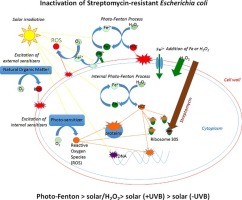Catalysis Today ( IF 5.2 ) Pub Date : 2017-10-27 , DOI: 10.1016/j.cattod.2017.10.033 Stefanos Giannakis , Samuel Watts , Sami Rtimi , Cesar Pulgarin

|
In this work, we assess the potential of solar light and the solar-assisted photo-Fenton process to inactivate antibiotic resistant bacteria (ARB) in wastewater (WW). A systematic investigation on ARB inactivation and regrowth kinetics after solar-based processes is intended, as well as the modification of their antibiotic resistance (AR). As such, a Streptomycin-resistant (SR) E. coli as a model ARB was subjected to solar exposure (with or without UVB light) at various irradiance levels, as well as the solar/H2O2 and the photo-Fenton process at neutral pH. We report the good fit of the SR E.coli to known kinetic models (>96% R2), and analytically present the necessary treatment timed for total inactivation and halting their post-treatment regrowth capability. For all treatment methods, the AR was found to decrease during treatment, prior to loss of cultivability (5–15% lower time for 4-log inactivation). UVB irradiation was determined as the key factor of loss of cultivability, AR and regrowth. Solar/H2O2 and photo-Fenton presented fast inactivation rates, ensured no regrowth of ARB, and indicated moderate effect on modifying the SR of E. coli, with similar inactivation times for both strains. The presence of Streptomycin in WW was found to act synergistically on the faster inactivation by all processes tested. Finally, ∼1 h of solar-based AOPs was found to ensure 4-log ARB inactivation and no regrowth, even in absence of the residual H2O2, indicating their suitability as proper WW disinfection processes.
中文翻译:

太阳光和光芬顿过程对废水中抗生素抗性细菌的影响:对链霉素抗性菌株的动力学研究
在这项工作中,我们评估了太阳光和太阳辅助光芬顿法灭活废水(WW)中抗药性细菌(ARB)的潜力。旨在对基于太阳的过程后ARB失活和再生动力学进行系统研究,以及对其抗药性(AR)的改进。这样,将抗链霉素(SR)的大肠埃希菌(ARB)置于各种辐照度下的太阳光照射下(有无UVB光),以及日光/ H 2 O 2和光芬顿法在中性pH下。我们报告了SR E.coli与已知动力学模型(> 96%R 2),并分析出必要的治疗时间,以使其完全失活并停止其治疗后的再生能力。对于所有治疗方法,发现在可培养性丧失之前,AR在治疗过程中都会降低(4-log灭活时间减少5-15%)。UVB辐射被确定为可培养性,AR和再生长损失的关键因素。Solar / H 2 O 2和光Fenton具有很快的灭活速率,确保了ARB不会再生,并且对修饰大肠杆菌的SR表现出适度的作用,两种菌株的灭活时间相似。发现WW中链霉素的存在对所有测试过程中更快的失活具有协同作用。最后,发现约1小时的太阳能AOP可以确保4 log ARB失活,即使没有残留的H 2 O 2也没有再生长,表明它们适合作为适当的WW消毒过程。











































 京公网安备 11010802027423号
京公网安备 11010802027423号